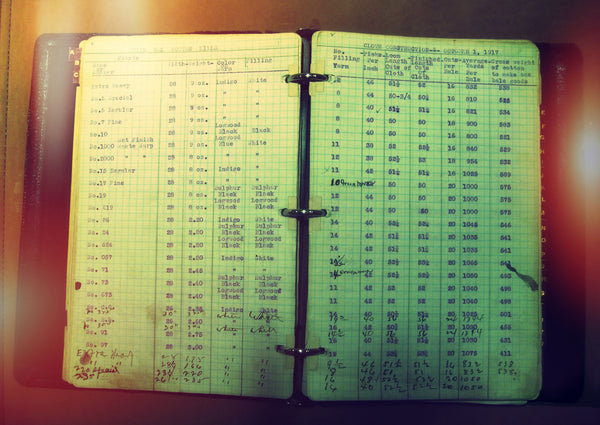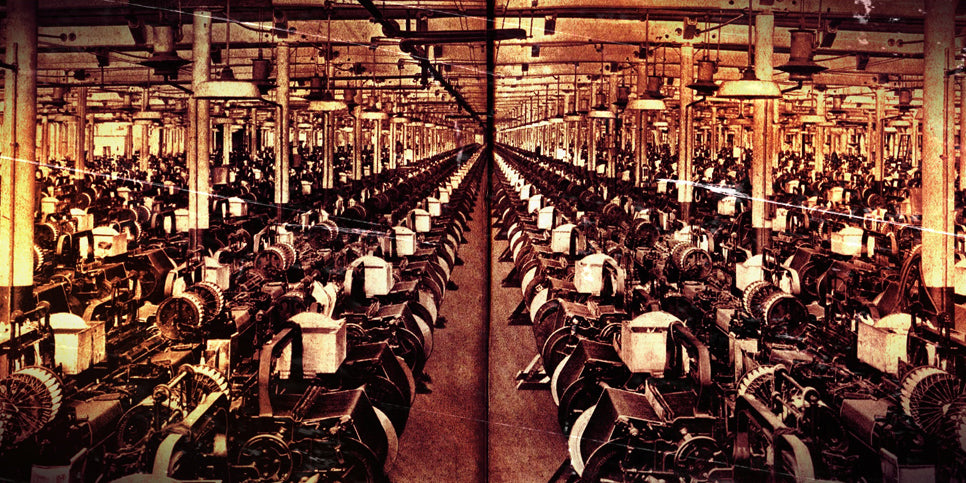The Imperfect Beauty of Selvage Denim
What's So Special About Selvage Denim?
Part of the allure of vintage denim is the individuality of each piece. Each garment is a picture in time of the spinner's work, the dyer's eye, the weaver's skill and the sewer's dedication. Suddenly the variations in the fabric caused by the differences in the cotton and old technology, considered so undesirable in manufacturing, are the very attributes so revered by denim aficionados and collectors.
Vintage denim pieces that have been worn have the added history of the owner. His/her occupation, how the garment was washed, whether they cuffed the jean or not, and sometimes what they carried in their pockets, all add to the unique "worn in" history of each piece.
The lower the technology used and the older the technology, the more variation we find, and the greater the likelihood of finding something of unique beauty. Today we can use high technology to duplicate the variations in yarn & dye, but we just can't get real selvage denim without a real shuttle loom.
Selvage/Selvedge
All woven fabric has a selvage of some type. Modern looms make a fringe selvage or a tucked selvage. The package of weft yarn does not travel back and forth across the loom, but rather a measured length of yarn is pulled or pushed across the loom. In both cases the yarn is cut after each insertion of the weft or 'pick'. A jet of air is a common way of inserting the weft yarn today. Fringe selvages do not withstand multiple washings very well. Tucked selvages are usually too wide or to thick to be used in a garment.
The selvage formed on a shuttle loom will not unravel because the yarn is not cut on each pick. It is quite suitable to be used as part of the garment without over edge sewing.
Wide versus Narrow
Today's shuttle-less weaving machines produce 68" wide fabrics. Narrow unfinished fabric at about 28" wide provided the right ratio of edge to square yards required.
Shuttle loom Weaving
 In the original shuttle weaving process, a small bobbin of yarn is carried inside a shuttle that travels back and forth across the loom. Since the weft yarn is not cut after each weft insertion the tightly bound edge cannot unravel (sometimes called a fast selvage). If used as part of a garment, it will maintain its integrity throughout the life of the garment. Cone Denim's White Oak plant's original Hopewell looms were installed in 1905 and produced 28" unfinished fabric. As the shuttle loom technology evolved, new wider shuttle looms were installed. By the 1950's the widths had increased to 42" to 45" on most fabrics, although a significant number of looms remained at 28".
In the original shuttle weaving process, a small bobbin of yarn is carried inside a shuttle that travels back and forth across the loom. Since the weft yarn is not cut after each weft insertion the tightly bound edge cannot unravel (sometimes called a fast selvage). If used as part of a garment, it will maintain its integrity throughout the life of the garment. Cone Denim's White Oak plant's original Hopewell looms were installed in 1905 and produced 28" unfinished fabric. As the shuttle loom technology evolved, new wider shuttle looms were installed. By the 1950's the widths had increased to 42" to 45" on most fabrics, although a significant number of looms remained at 28".
As the looms became wider, fewer garment producers utilized this selvage. Garment parts inside vintage jackets, shirts, overalls, and jeans may show one or more garment parts where the selvage was used.
Because of the high weight of the shuttle, the 28" shuttle looms were very slow by today's standards. They produced lots of defects and uneveness in the weave. The uneveness in yarn tensions and the lack of precision in controlling weft yarn spacing creates a different appearance in denim as compared to modern looms. In the late 1960's and early 1970's the transition to shuttle - less looms were much faster and produced a more consistent fabric, but the selvage was no longer usable in garments because it would not withstand multiple washings.
Selvage Jeans
 Cone Denim's White Oak plant was built in 1905. At one point it had 3,000 shuttle looms producing 28" selvage denim. The fabric was the ideal width for making jeans where the selvage is used in all four major garment panels and forms the side seams of the jean. White Oak plant records from 1917 show various shades and weights. There is a record of the number of selvage yarns, 12 white ends on each side in most cases, but no indication of selvage thread color. However, the old construction book from the 50's and 60's does identify many selvage colors. Most of them had one or two ends of color in a field of white.
Cone Denim's White Oak plant was built in 1905. At one point it had 3,000 shuttle looms producing 28" selvage denim. The fabric was the ideal width for making jeans where the selvage is used in all four major garment panels and forms the side seams of the jean. White Oak plant records from 1917 show various shades and weights. There is a record of the number of selvage yarns, 12 white ends on each side in most cases, but no indication of selvage thread color. However, the old construction book from the 50's and 60's does identify many selvage colors. Most of them had one or two ends of color in a field of white.
Authenticity of Denim
There are numerous changes through the years that affected the appearance of denim, but the major ones are the loss of shuttle loom weaving and the introduction of Open End Spun yarns. Those big changes, plus the pre-washing of jeans made a significant difference in the way denim garments look on the street today.
To duplicate authentic vinatge denim, including the fast selvage, presents a significant challenge. Cone Mills White Oak Denim Indigo Selvage fabrics take authenticity to new levels by weaving on refurbished Draper X-3 shuttle looms. These looms have the slow, gentle weaving, mechanics which produces a lot of variations and defects in the fabric very much like the Honeywell looms of the early 1900's.

Snap, Crackle & Pop
Shuttle looms are a lot like a record player (well for this analogy at least). The record player, along with the vinyl record produce an analog warmth in the listening experience that is not present in modern digital playback. The imperfect sound is precisely what makes it a unique and enjoyable listening experience, each record different from the next due to these sound imperfections. Shuttle looms produce a lot of imperfections during the weave process - the snap, crackle & pop if you will, that give selvedge denim its distinct appearance. We have listed here what some of these weave imperfections look like, and, if you're lucky could be visible on your selvedge denim.

We hope this short synopsis of the weaving of process clarifies the difference between selvedge denim and non-selvedge denim. If not please feel free to chat us on any product page that you see the chat icon or send us an email customerservice@bravestarselvage.com



